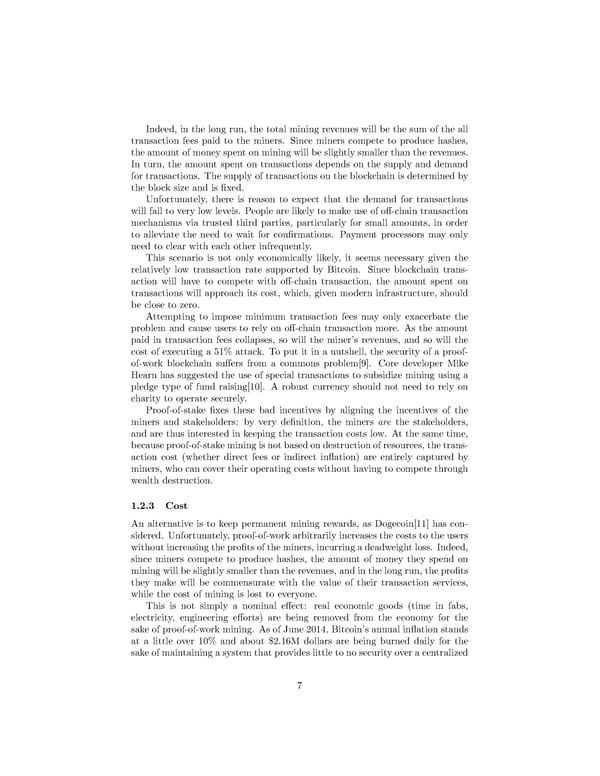Indeed, in the long run, the total mining revenues will be the sum of the all transaction fees paid to the miners. Since miners compete to produce hashes, the amount of money spent on mining will be slightly smaller than the revenues. In turn, the amount spent on transactions depends on the supply and demand for transactions. The supply of transactions on the blockchain is determined by the block size and is fixed. Unfortunately, there is reason to expect that the demand for transactions will fall to very low levels. People are likely to make use of off-chain transaction mechanisms via trusted third parties, particularly for small amounts, in order to alleviate the need to wait for confirmations. Payment processors may only need to clear with each other infrequently. This scenario is not only economically likely, it seems necessary given the relatively low transaction rate supported by Bitcoin. Since blockchain trans- action will have to compete with off-chain transaction, the amount spent on transactions will approach its cost, which, given modern infrastructure, should be close to zero. Attempting to impose minimum transaction fees may only exacerbate the problem and cause users to rely on off-chain transaction more. As the amount paid in transaction fees collapses, so will the miner’s revenues, and so will the cost of executing a 51% attack. To put it in a nutshell, the security of a proof- of-work blockchain suffers from a commons problem[9]. Core developer Mike Hearn has suggested the use of special transactions to subsidize mining using a pledge type of fund raising[10]. A robust currency should not need to rely on charity to operate securely. Proof-of-stake fixes these bad incentives by aligning the incentives of the miners and stakeholders: by very definition, the miners are the stakeholders, and are thus interested in keeping the transaction costs low. At the same time, becauseproof-of-stake mining is not based on destruction of resources, the trans- action cost (whether direct fees or indirect inflation) are entirely captured by miners, who can cover their operating costs without having to compete through wealth destruction. 1.2.3 Cost An alternative is to keep permanent mining rewards, as Dogecoin[11] has con- sidered. Unfortunately, proof-of-work arbitrarily increases the costs to the users withoutincreasing the profits of the miners, incurring a deadweight loss. Indeed, since miners compete to produce hashes, the amount of money they spend on mining will be slightly smaller than the revenues, and in the long run, the profits they make will be commensurate with the value of their transaction services, while the cost of mining is lost to everyone. This is not simply a nominal effect: real economic goods (time in fabs, electricity, engineering efforts) are being removed from the economy for the sake of proof-of-work mining. As of June 2014, Bitcoin’s annual inflation stands at a little over 10% and about $2.16M dollars are being burned daily for the sake of maintaining a system that provides little to no security over a centralized 7
 A Self-Amending Crypto-Ledger Position Paper Page 8 Page 10
A Self-Amending Crypto-Ledger Position Paper Page 8 Page 10